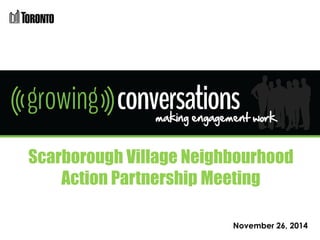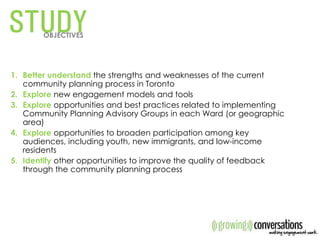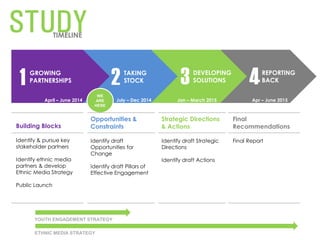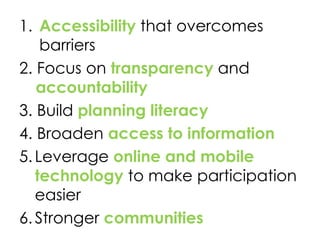Growing Conversations - Project Update
- 1. Scarborough Village Neighbourhood Action Partnership Meeting November 26, 2014
- 2. How do we make Toronto the most engaged city in North America?
- 3. STUDY OBJECTIVES 1. Better understand the strengths and weaknesses of the current community planning process in Toronto 2. Explore new engagement models and tools 3. Explore opportunities and best practices related to implementing Community Planning Advisory Groups in each Ward (or geographic area) 4. Explore opportunities to broaden participation among key audiences, including youth, new immigrants, and low-income residents 5. Identify other opportunities to improve the quality of feedback through the community planning process
- 4. VISION: To become North America’s most engaged Opportunities for Change IMPLEMENTATION 1 Strategic Direction 2 Strategic Direction 3 Strategic Direction city on planning issues STUDY FRAMEWORK Pillars of Effective Engagement Actions Actions Actions
- 5. STUDY ELEMENTS Stakeholder Partnership Strategy Ethnic Media Strategy Engagement Action Plan Youth Engagement Strategy Open Data Framework
- 6. STUDY TIMELINE 1 GROWING 2 3 Building Blocks Identify & pursue key stakeholder partners Identify ethnic media partners & develop Ethnic Media Strategy Public Launch WE ARE HERE Opportunities & Constraints Identify draft Opportunities for Change Identify draft Pillars of Effective Engagement PARTNERSHIPS TAKING STOCK April – June 2014 YOUTH ENGAGEMENT STRATEGY July – Dec 2014 DEVELOPING SOLUTIONS Jan – March 2015 4REPORTING BACK Apr – June 2015 Strategic Directions & Actions Identify draft Strategic Directions Identify draft Actions Final Recommendations Final Report ETHNIC MEDIA STRATEGY
- 8. WHY? DO WE ENGAGE ► To build capacity and inform participation ► To inform planning processes ► To facilitate city building
- 9. HOW? DO WE ENGAGE 1. When we receive a development application 2. When a neighbourhood-based planning process is initiated 3. When a city-wide planning process or special study is initiated 4. When we want to talk about city building
- 11. What we’ve heard
- 12. 1. Accessibility that overcomes barriers 2. Focus on transparency and accountability 3. Build planning literacy 4. Broaden access to information 5. Leverage online and mobile technology to make participation easier 6. Stronger communities
- 13. NEXT STEPS • Youth Engagement Strategy to be completed by late January 2015 • Staff workshop in January 2015 to analyze feedback and develop draft Principles for Effective Engagement & draft Opportunities for Change • Second round of consultations – early 2015 • Affirm draft Principles for Effective Engagement & draft Opportunities for Change • Develop draft Strategic Directions • Develop draft Actions • Open Data Framework • Final report to Council in mid to late 2015
Editor's Notes
- Growing Conversations is an exciting initiative from the City of Toronto to help make Toronto the most engaged city in North America. Growing Conversations is central to the effort to improve participation in the planning process. This city-wide initiative will offer a variety of opportunities for residents to engage with planning staff to craft a better consultation process. Let’s talk!
- Ethnic Media Strategy – Cantonese, Mandarin, Spanish, Tamil and Tagalog
- Growing Conversations is an exciting initiative from the City of Toronto to help make Toronto the most engaged city in North America. Growing Conversations is central to the effort to improve participation in the planning process. This city-wide initiative will offer a variety of opportunities for residents to engage with planning staff to craft a better consultation process. Let’s talk!
- Growing Conversations is an exciting initiative from the City of Toronto to help make Toronto the most engaged city in North America. Growing Conversations is central to the effort to improve participation in the planning process. This city-wide initiative will offer a variety of opportunities for residents to engage with planning staff to craft a better consultation process. Let’s talk!
- 1. An accessible planning process ensures that people feel welcome and are able to participate freely. Improvements to the engagement process should focus on accessibility and access to information related to the planning process. This includes overcoming linguistic barriers, making more regular use of plain language, offering a variety of mediums for engagement and scheduling meetings at times that suit differing schedules. 2. When people don't understand how their feedback has been used to inform planning, transparency and accountability suffers. Making a stronger connection between inputs from the community and project outcomes by being clearer about where feedback is going, and how it has been used can only increase the accessibility and transparency of the planning process. 3. The planning process in Ontario is complex and difficult to navigate, and this can be intimidating to many people, creating a barrier to participation. It also leads to frustration when people don't understand how the planning process itself influences planning outcomes. Building Torontonians' understanding of basic planning concepts, principles and processes will go a long way towards making engagement more relevant. 4. Many Torontonians find it difficult to find and access information related to development applications or planning processes happening in their communities. This includes access information regarding the time and locations of meetings and updates on development applications. Improving access to this information should promote greater participation. Open Data can play a key role in broadening access to information. 5. People are looking for new ways to participate in planning processes beyond the traditional community meeting. Canada has one of the highest internet penetration rates in the world, with well over 85% of Canadians enjoying access to an internet connection, and close to 60% have a smartphone. While City Planning has already begun to make better use of these technologies, there is an opportunity to leverage them even further in order to make participation easier and more convenient. 6. Toronto is a very different place than it was in the 70s, when neighbourhood planning offices exited across the city. Residents today feel disconnected from the Community Planners who are responsible for planning their neighbourhoods. Giving Community Planners a more prominent community role will help to build stronger relationships with the community, and promote transparency and accountability.














